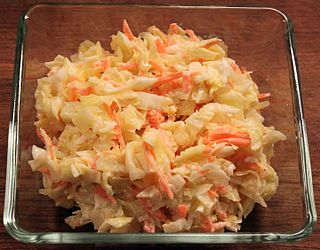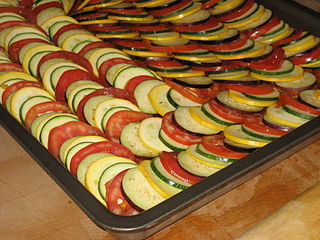
Couscous is a Maghrebi dish of small steamed balls of crushed durum wheat semolina that is traditionally served with a stew spooned on top. Pearl millet and sorghum, especially in the Sahel, and other cereals can be cooked in a similar way and the resulting dishes are also sometimes called couscous. Pearl or Israeli couscous, properly known as ptitim, is a type of pasta.

Herbes de Provence is a mixture of dried herbs considered typical of the Provence region of southeast France. Formerly simply a descriptive term, commercial blends started to be sold under this name in the 1970s. These blends often contain savory, marjoram, rosemary, thyme, and oregano. Lavender leaves are also included in products in the North American market. The herb mixture is typically used with grilled foods and stews.

Gumbo is a soup popular in the U.S. state of Louisiana, and is the official state cuisine. Gumbo consists primarily of a strongly-flavored stock, meat or shellfish, a thickener, and three kinds of vegetables ― celery, bell peppers, and onions. Gumbo is often categorized by the type of thickener used, whether okra or filé powder.

Jambalaya is a popular dish of West African, French, and Spanish influence, consisting mainly of meat and vegetables mixed with rice. Traditionally, the meat always includes sausage of some sort, often a smoked meat such as andouille, along with pork or chicken and seafood, such as crawfish or shrimp. The vegetables are usually a sofrito-like mixture known as the "holy trinity" in Cajun cooking, consisting of onion, celery, and green bell pepper, though other vegetables such as okra, carrots, tomatoes, chilis and garlic are also used. After browning and sauteeing the meat and vegetables, rice, seasonings and broth are added and the entire dish is cooked together until the rice is done.

Pilaf or pilau is a rice dish or, in some regions, a wheat dish, whose recipe usually involves cooking in stock or broth, adding spices, and other ingredients such as vegetables or meat, and employing some technique for achieving cooked grains that do not adhere.

A casserole is a variety of a large, deep pan or bowl, typically with a glass lid, used for oven cooking a variety of dishes, as well as referring to the category of foods cooked inside it. Though the two share the same name, the pan itself is also commonly known as a "casserole dish" or "casserole pan", whereas the food inside is usually distinguished as the "casserole". The same pan is often used both for cooking and serving.

Bouillabaisse is a traditional Provençal fish stew originating from the port city of Marseille. The French and English form bouillabaisse comes from the Provençal Occitan word bolhabaissa, a compound that consists of the two verbs bolhir and abaissar.

Coleslaw, also known as cole slaw or simply slaw, is a side dish consisting primarily of finely shredded raw cabbage with a salad dressing, commonly either vinaigrette or mayonnaise. Coleslaw prepared with vinaigrette may benefit from the long lifespan granted by pickling.

Irish stew is a lamb or mutton and root vegetable stew native to Ireland. As in all traditional folk dishes, the exact recipe is not consistent from time to time, or place to place. Basic ingredients include lamb, or mutton, as well as potatoes, onions, and parsley. It may sometimes also include carrots. Irish stew is also made with kid goat.
Irish stew is a celebrated Irish dish, yet its composition is a matter of dispute. Purists maintain that the only acceptable and traditional ingredients are neck mutton chops or kid, potatoes, onions, and water. Others would add such items as carrots, turnips and pearl barley; but the purists maintain that they spoil the true flavour of the dish. The ingredients are boiled and simmered slowly for up to two hours. Mutton was the dominant ingredient because the economic importance of sheep lay in their wool and milk produce and this ensured that only old or economically non-viable animals ended up in the cooking pot, where they needed hours of slow cooking. Irish stew is the product of a culinary tradition that relied almost exclusively on cooking over an open fire. It seems that Irish stew was recognised as early as about 1800.

A tajine or tagine is a Maghrebi dish which is named after the earthenware pot in which it is cooked. It is also called maraq or marqa.

Peasant foods are dishes specific to a particular culture, made from accessible and inexpensive ingredients, and usually prepared and seasoned to make them more palatable. They often form a significant part of the diets of people who live in poverty, or have a lower income compared to the average for their society or country.

Mediterranean cuisine is the foods and methods of preparation by people of the Mediterranean Basin. The idea of a Mediterranean cuisine originates with the cookery writer Elizabeth David's book, A Book of Mediterranean Food (1950) and was amplified by other writers working in English. Many writers define the three core elements of the cuisine as the olive, wheat, and the grape, yielding olive oil, bread and pasta, and wine; other writers emphasize the diversity of the region's foods and deny that it is a useful concept. A common definition of the geographical area covered follows the distribution of the olive tree.

Ratatouille is a French Provençal stewed vegetable dish, originating in Nice, and sometimes referred to as ratatouille niçoise. Recipes and cooking times differ widely, but common ingredients include tomato, garlic, onion, courgette (zucchini), aubergine (eggplant), bell pepper, and some combination of leafy green herbs common to the region.

Soup is a primarily liquid food, generally served warm or hot, that is made by combining ingredients of meat or vegetables with stock, or water. Hot soups are additionally characterized by boiling solid ingredients in liquids in a pot until the flavors are extracted, forming a broth. Soups are similar to stews, and in some cases there may not be a clear distinction between the two; however, soups generally have more liquid (broth) than stews.

Tiella is a dish in Italian cuisine that is prepared with potato, rice, onion and mussels as primary ingredients. Additional ingredients may be used. Variations of the dish exist, and some may be prepared with other types of seafood. The round earthenware dish in which tiella is traditionally cooked is also referred to as a "tiella". Tiella is part of the cuisine of Apulia in southern Italy. It may also be found in coastal areas of Calabria.

A stew is a combination of solid food ingredients that have been cooked in liquid and served in the resultant gravy. Ingredients in a stew can include any combination of vegetables and may include meat, especially tougher meats suitable for slow-cooking, such as beef, poultry, sausages, and seafood. While water can be used as the stew-cooking liquid, stock is also common. A small amount of red wine is sometimes added for flavour. Seasoning and flavourings may also be added. Stews are typically cooked at a relatively low temperature, allowing flavours to mingle.

Cabbage stew is a stew prepared using cabbage as a primary ingredient. Basic preparations of the dish use cabbage, various vegetables such as onion, carrot and celery, and vegetable stock. Additional ingredients can include meats such as pork, sausage and beef, potatoes, noodles, diced apples, apple juice, chicken broth, herbs and spices, salt and pepper.

Garlic sauce is a sauce prepared using garlic as a primary ingredient. It is typically a pungent sauce, with the depth of garlic flavor determined by the amount of garlic used. The garlic is typically crushed or finely diced. Simple garlic sauce is composed of garlic and another ingredient to suspend the tuber via emulsion, such as oil, butter or mayonnaise. Various additional ingredients can be used to prepare the sauce.


















